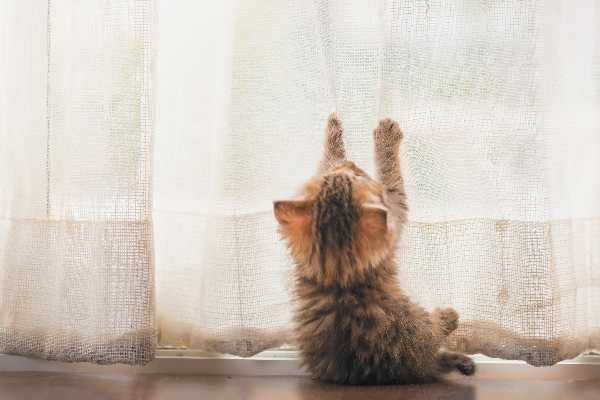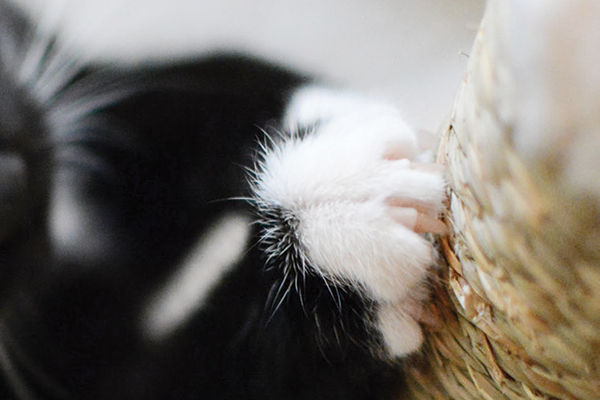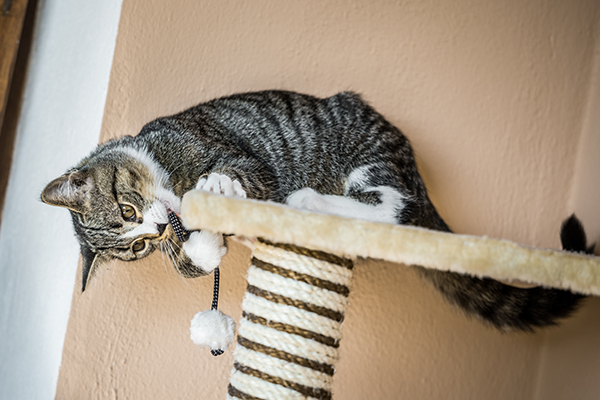Jack’s cat tree — set up right in front of the sliding glass door in our living room for easy bird- and human-watching — has seen much better days. The carpet on the top level is bare in a few spots, and though I vacuum it frequently, it always seems to have about a cat’s worth of fur scattered across it. Yet, Jack loves that cat tree and scratches it multiple times per day. I consider it an eyesore, but I know I should leave it right where it is, because Jack gravitates toward it instead of the couch. Such a strategy will likely continue to protect my couch. Pam Johnson-Bennett, a certified cat behaviorist, says that keeping a suitable scratching post or scratching surface in high-traffic areas of the house can help encourage appropriate cat scratching behavior.
“You have to provide a scratching post that meets his needs,” she says, noting that while scratching preferences vary among cats, some scratching post features appeal to most. “Make sure you have a scratching post that meets the qualifications: appealing texture, tall enough, stable and placed in a good location.”
The Best Scratching Post for Kittens

Kittens begin to develop their scratching post preferences from a young age. While most cats stretch upward to scratch (such as on a cat tree or post), some cats prefer to scratch a horizontal surface like the base of a cat tree or a cardboard pad. And while many cat trees are covered with carpet, your cat may prefer a different surface, such as cardboard or sisal rope.
“In general, the most appealing texture for cats is sisal,” Johnson-Bennett says. “The rough texture makes it easy for cats to dig their claws in and get an effective scratch.”
Don’t worry: If your kitten starts scratching on an item that you’d prefer to keep off-limits — such as furniture like the living room couch — you can easily redirect him to a more appropriate item while he’s still learning scratching behaviors. Place a scratching post next to the area where he’s scratching, and make the inappropriate area as unappealing as possible (block his access, or cover the spot with sticky tape or tinfoil). Praise your kitten when he uses the scratching post, then keep it nearby when he starts using it consistently.
Do this: Cats need to scratch for multiple reasons. If your kitten doesn’t have a suitable outlet like a scratching post for his scratching behaviors, he will find another spot to do so. Avoid unpleasant scratching situations by accommodating his needs from the very beginning.
The Best Scratching Post for Adult Cats

While scratching serves many functions for cats, adults use the behavior to mark their territory. “The marks left on an object when the cat rakes his claws vertically create a visual sign for others who pass by,” Johnson-Bennett explains. “When the cat scratches an object, he also leaves an olfactory mark by way of scent glands in the paw pads. This way, should another cat approach the scratch mark, he would be able to gather information from the pheromones (scent chemicals).”
Our feline crew does a decent job marking their territories on their scratching posts and cat trees, and to encourage that behavior we have four scratching posts positioned throughout the house. Two are in our open-plan living and dining room area, where the humans of the household spend most of our time, and two are in the master bedroom, where the cats spend most of their napping time. Johnson-Bennett says that strategy works best for multi-cat households.
“If you have more than one cat, you’ll need more than one scratching post,” she explains. “Although you can’t specifically assign a post to a specific cat, if you place the posts in areas where the different cats tend to spend the most time, you may find they may just claim the posts on their own.”
Don’t worry: If you find what look like claws near your cat’s scratching post, don’t panic. One of the reasons your cat scratches is to keep his claws in good shape, and the act of scratching helps remove the outer layer of material from his claws.
Do this: You can help keep your cat’s claws in good shape by trimming them regularly. This may also help protect more delicate fabrics and upholstery in your home from becoming snagged by your cat’s claws. Most cat experts, however, discourage having cats declawed, as the surgery can have painful lasting effects.
The Best Scratching Post for Senior Cats

As your cat ages, he still needs to scratch to exercise his muscles and stretch his limbs. For a senior cat, having a scratching post readily available can make it easier for him to continue these healthy behaviors.
Scratching can be an emotional release for your cat no matter what his age, Johnson-Bennett says. “When your cat is anxious, happy, excited or frustrated, he can release some of that built-up emotion by scratching. Think of the times you’ve seen your cat scratching on an object after a nap or when you’ve come home from work. You may even have noticed him scratching after an encounter with a companion cat. This emotional release through scratching is healthy for the cat.”
Don’t worry: As Johnson-Bennett says, don’t be alarmed if your cat suddenly races through the house to begin furiously scratching his post. Instead, be grateful that he prefers his post to your favorite lounge chair.
Do this: Because your cat needs to stretch his muscles when he scratches, make sure the scratching post is tall enough for him to stretch out. While those cute little scratching posts at the pet store may work well for a young kitten, your senior cat needs a tall scratching post so he can stretch to his full length. If his post isn’t tall enough, your cat will likely seek out a taller place to scratch — including your fabric headboard.
Thumbnail: Photography © marima-design | Thinkstock.
This piece was originally published in 2017.
Tell us: What type(s) of scratching post does your kitty like?
About the author
A lifelong cat owner, Stacy N. Hackett writes frequently about cats, cat breeds and a range of pet-related topics. The inspiration for her writing comes from her four cats — Jack, Phillip, Katie and Leroy —and her Cocker Spaniel/Labrador Retriever mix, Maggie.








